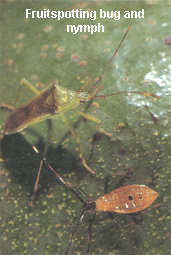| Organic Seeds | Edible Plants | Organic Pest Controls | Books | Tools, Propagation & Fertilisers | Sprouting & Microgreens | Poultry Supplies | Specials & Gift Ideas |

Top

We will send an email to this address*
when is next available
* we will use this email address only for this notification and then we will delete it.
 Home
Home
Green Harvest Organic Gardening Supplies is permanently closed as of 5pm on 1-11-2023.
We will not be taking orders by this website, in person, by phone or email. Our display garden and retail shop are closed forever.
Read more...
Phone:07 54357000
Phone calls will only be responded to sporadically and only in reference to orders placed prior to 2-11-2023. All the useful growing and organic pest management research and resources are available on this website for a while still.
Fruitspotting Bug Control © Frances Michaels
 This pest is a native sap-sucker and often attacks orchard trees close to bushland.
This pest is a native sap-sucker and often attacks orchard trees close to bushland.
Suggested Organic Strategies
Suggested Products:
Pyrethrum
 This pest is a native sap-sucker and often attacks orchard trees close to bushland.
This pest is a native sap-sucker and often attacks orchard trees close to bushland.Suggested Organic Strategies
- Careful re-design is needed to increase diversity, often there is a lack of understorey in the nearby bush, which would normally be a habitat for natural predators of the bug. A thick planting of native shrubs between the bush and the orchard, or around the orchard boundary will create niches for longer-lived predators of bugs such as birds, spiders, assassin bugs, tachinid flies, chalcid wasps and ground beetles. The shrubs also act as a physical barrier to flying insects.
- Cover cropped orchards support more soil dwelling predators and generally have a lower number of pests than bare or grassed orchards.
- Improve the habitat for birds by providing safe nest sites, food and water.
- Poultry may also help, so keep either chooks, guinea fowl or ducks as they all eat large numbers of insects. Guinea fowl are a lot more feral than chooks, roost in trees at night and may be better at catching flying insects like the Fruitspotting bug.
- Small ponds encourage useful predators of insects such as frogs and dragonflies, which need water to breed.
- To encourage beneficial insects, it is important to avoid the use of pesticides wherever possible.
Suggested Products:
Pyrethrum
 Home
Home
Green Harvest Organic Gardening Supplies is permanently closed as of 5pm on 1-11-2023.
We will not be taking orders by this website, in person, by phone or email. Our display garden and retail shop are closed forever.
Read more...
Phone:07 54357000
Phone calls will only be responded to sporadically and only in reference to orders placed prior to 2-11-2023. All the useful growing and organic pest management research and resources are available on this website for a while still.
No liability will be accepted by Green Harvest, its owners or employees as to the accuracy of any information. No responsibility will be taken for damage to property or persons due to information given about a product or technique. No responsibility will be taken for the loss of a crop or income due to information given about a product or technique.
 Shopping here is private and secure.
Shopping here is private and secure.
Copyright © 2001 - 2024 Green Harvest Organic Gardening Supplies
No part of this website may be reproduced without permission of the owner